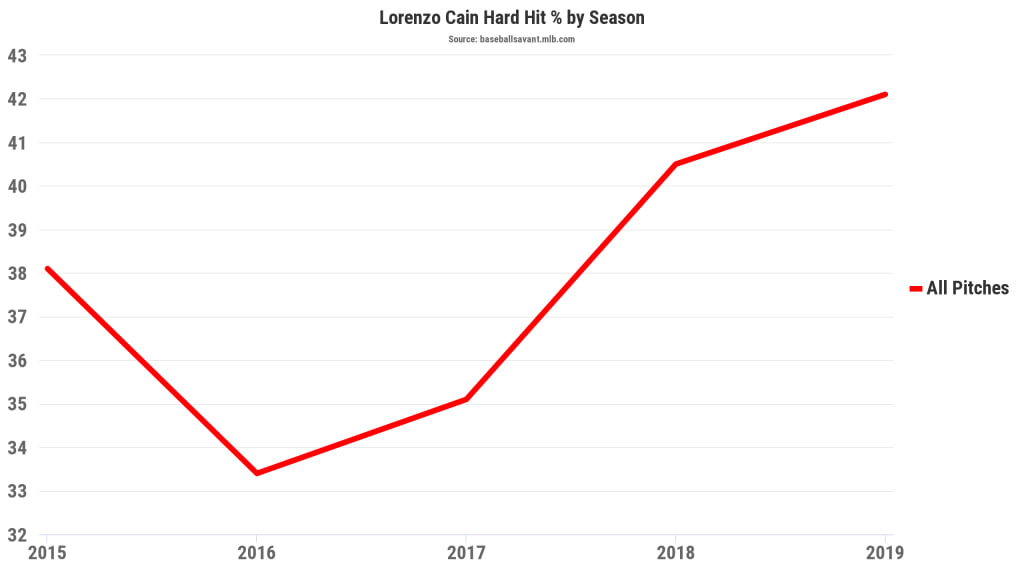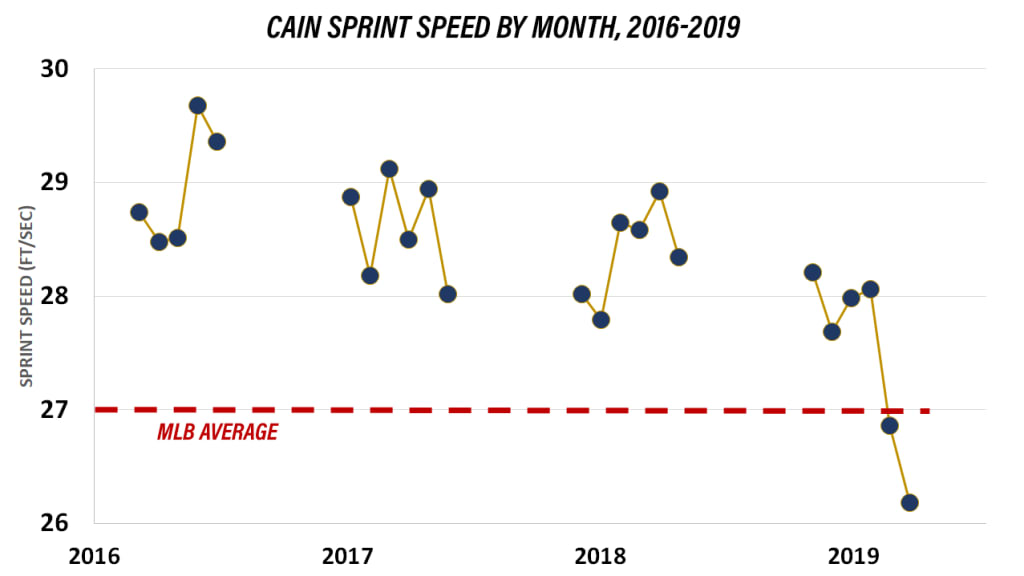Just over two years ago, on the same day they traded for Christian Yelich, the Brewers signed Lorenzo Cain to a five-year deal worth $80 million. It went great, at first; in 2018, Cain hit .308/.395/.417 with 30 steals and his usual excellent defense, making the All-Star team and finishing seventh in the Most Valuable Player balloting. It was one of the best outfield seasons in Milwaukee history to that point. The Brewers won their division.
In 2019, it went ... considerably less great, as Cain hit a mere .260/.325/.372. Among qualified hitters, he had the second-largest drop in WAR (from 5.7 to 1.5) and the fifth-largest drop in OPS (from .813 to .697). The Brewers won seven fewer games and lost the Wild Card game.
In 2020 ... well, we don't know what's going to happen. Cain turns 34 in April. He still has three years left on his contract, but more urgently, the 2020 Brewers lineup has shed Yasmani Grandal, Mike Moustakas, Eric Thames, Jesús Aguilar, and Travis Shaw from last year. Ryan Braun is 36. Yelich, as great as he's been, is recovering from a serious knee injury. There are a lot of questions about their position in a tight NL Central, is the point, and what Cain can provide is going to be a huge part of the equation.
It's easy to say that 2020 was the start of a decline for a speed-reliant player entering his 11th season in the big leagues. But it's never as simple as that, and it's not that simple here, either. There are, fortunately, a few things to like about Cain headed forward.
The good news!
When a player on the wrong side of 30 has a suddenly poor season, there are a few obvious things you'd look for. Maybe he started striking out more. Maybe he stopped hitting it as hard. Maybe it's both. Maybe it's the beginning of the end. Time comes for us all, right?
Well, yes. But before we start to spiral too deeply here, there are a few things worth noting about Cain's 2019 that might be instructive for his 2020. To begin with, he didn't have problems with hitting the ball hard in 2019. He actually hit it harder than ever, pushing his hard-hit rate up to 42%, which would be the third year in a row that his hard-hit rate improved over the previous year.

So that's a good start, and so is the fact that he still made above-average contact; a 17% strikeout rate is up from the 15.2% he had in 2018, but it's still better than both the MLB average and his own career average. Nor is it that he put the ball on the ground more, because his ground ball rate of 50% was lower than 2018's, and in line with his career average.
When we roll all that together -- how hard he hit it, how high, how much contact he made -- into our Expected Weighted On-Base Average metric, we see that his .330 in '19 was only down slightly from his .342 in '18, and still better than the .319 Major League average. This is all good.
It gets better. The most important Statcast metric is probably the barrel, which attempts to find batted balls that have the perfect combination of exit velocity and launch angle, regardless of whether the ball is robbed for an out by a great fielder or held up by a stiff wind. As FanGraphs wrote just a few days ago:
"Barrels, and particularly barrel rate, are great statistics. They’re descriptive and predictive at the same time; a player with a high barrel rate likely did a ton of damage on contact, and they’re also likely to maintain a high barrel rate the next year."
Cain, for what it's worth, has had no decline in his barrel rate, hovering at about 4% each of the last four years; he had 19 in 2019, and he's averaged 16 annually since 2016. Raw power isn't his game -- we'll get back to that, because obviously he didn't perform well overall anyway -- but that there's no decline here is a strong sign.
There's good news on defense, too. Despite myriad injuries -- ankle, knee, and thumb -- Cain's fielding remained excellent. It's not just the Gold Glove win, his first, so much as it was the +14 Outs Above Average, which ranked eighth overall and third among outfielders.
Let's pause here for a moment to roll his incredible catch to rob Garrett Hampson on the final weekend of the season. It's not necessarily an important part of our analysis, but it is tremendous.
OK, so that's the good news. But Cain's year didn't go well, and that all matters more than hard-hit rates. What happened?
What went wrong: The opposing defense
We're generally hesitant to put too much emphasis on "bad luck," because that's too often used as an easy way to hand-wave away under-performance without getting to the real root of the issue. That's true here, too, but we'd be remiss not to at least note how much Cain was hurt by good defense, if not necessarily bad luck.
One way we can get to that is by taking all of our Statcast defensive metrics and looking at them from the point of view of the hitter, not the fielder. Above, we said that Cain was worth 14 Outs Above Average on defense. How did the opposing fielders do when he was the hitter? This is entirely based on how difficult their chances were, not Cain's performance.
As it turns out, only one hitter was harmed by excellent defense, expressed again in Outs Above Average, against them more than Cain was.
+12 José Altuve, HOU
+11 Cain, MIL
+10 Brett Gardner, NYY
+ 9 Dee Gordon, SEA
(You can see how all of the Brewers hitters fared here. Yelich actually benefited from poor defense against him, as you can see in examples like this one on July 15.)
If you want to see what that looks like, it looks like this, when Starling Marte robbed him on a play that had a mere 40% Catch Probability.
And it looks like this, on play that's more difficult than Andrelton Simmons made it seem.
If you really want to understand what happened to Cain, just look at his hardest-hit ball of the season, a rocket at 110.4 MPH right off of pitcher Tyler Chatwood ... but right to second baseman Ben Zobrist.
This is probably not predictive, or something that anyone should be worried about for 2020. But it was a thing that happened a lot in 2019, and it definitely seemed to hurt him.
"He’s had a poor-luck season, and that’s reflected in the numbers," Milwaukee manager Craig Counsell told MLB.com last August. "He was flirting with a .400 on-base percentage [in 2018] -- that’s the difference. It’s probably not all made up by bad luck, but since his thumb’s fixed, I think his at-bats and quality of contact have been pretty similar.”
Counsell's exactly right, especially when he talks about "quality of contact," as we dove into above. There's also this -- when we look at who had the most hard-hit balls turn into outs or errors, Cain was ever so close to being at the top.
118 -- Mookie Betts, BOS
115 -- D.J. LeMahieu, NYY
114 -- Cain, MIL
Another way of putting that is that on hard-hit balls, Cain had an average of .405 ... which sounds great, until you realize that A) the Major League average on those hard-hit balls was .542 and B) it's the lowest average of the 258 players who had at least 75 hard-hit balls.
So Cain probably deserved better than he got, but he didn't get it, and maybe that's partially due to good defense or poor luck. It can't possibly be entirely due to that, though. It's not. What else was it?
What might actually be wrong: the speed
As we said, Cain dealt with knee and ankle problems last year, and that can't be discounted. But he's also about to be 34, and that can't be discounted either, especially now that we can measure speed, and that we know how heavily correlated youth is to speed. For Cain, we can see some trends over the years.
Here, for example, is a trend. You're probably more interested in his ranking than the raw feet per second number.
• 2016: 29.1 ft/sec -- 39th-best overall
• 2017: 28.8 ft/sec -- 75th-best overall
• 2018: 28.6 ft/sec -- 97th-best overall
• 2019: 27.8 ft/sec -- 197th-best overall
If you're more of a visual learner:

Again: We know that he was not fully healthy at the end of last season, as that chart makes clear. And Cain, earlier this month, made clear that he knew about it too, making changes to his diet and exercise routine.
“I feel like I had a disappointing season last year, and I feel like I need to do everything possible to get it right," he said. "I need to make sure my legs are underneath me. I lost a lot of weight this offseason, I’m trying to get a little lighter on my feet. Overall, just trying to stay healthy and improve on my disappointing season last year.”
That said, it it wasn't a one-year fluke, either, and that's not unexpected as any player ages. Remember, we said way back up at the top that Cain was still hitting the ball as hard as ever, and still barreling it up as well as ever. He actually had more extra base hits (41) in 2019 than he did in 2018 (37).
But, he had 24 fewer singles than '18 in nearly the exact same number of plate appearances. That, along with 21 fewer walks, explains nearly the entirety of his down 2019. Now, check out where those lost singles came from.
Pop-ups? No. Pop-ups are bad. Don't hit them. (No hits either year.)
Liners? Nope. Exactly 51 line drive singles in each of the last two seasons.
Flies? Nah. Flies aren't usually singles. He's had just 10 total the last two years.
Grounders? There it is: 72 in 2018, but 50 in '19.
Cain hit .311 on grounders in 2018, and .239 on them in 2019. Maybe some of that was due to the great defense he faced. Maybe some of it was because the speed maybe isn't quite what it was, though it's still above average. Maybe that production will never get back to what it was. Projection systems, understandably, are all over the place on this; Steamer sees an exactly league-average 100 wRC+; ZiPS says a poor 92 wRC+; PECOTA checks in at an above-average 113.
But the likeliest outcome here, we think, is somewhere in the middle. Cain probably won't repeat that elite 2018 again, yet all the underlying signs that he's showing us with his bat have to say he'll outdo his 2019. If he's league-average with the bat, paired with that still-outstanding glove, he can still be a star. For a Brewers team that's got three other competitors in their division, they'll need him to be.
